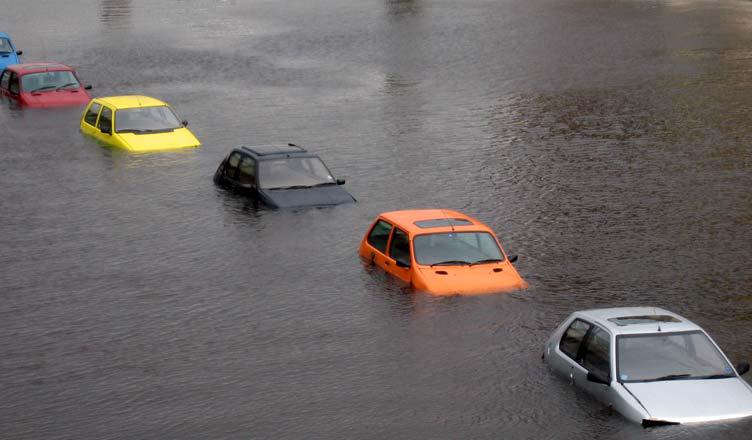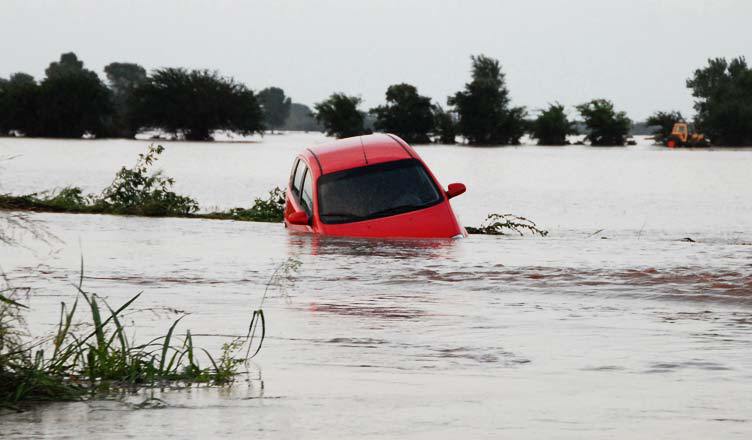Extreme weather has once again hit the UK, with widespread flooding across the north of England causing untold damage and misery. Flooding can catch you by surprise, and if the weather is severe enough, just getting in your car and driving away is not an option. So one of the biggest casualties of flood damage is the car. If your car is caught in the floods, can you do anything to save it? Or is it destined for the scrapheap? We’ve collected together some top advice and tips from across the web to help you work out if your flood damaged car can be saved.

A nightmare scenario for drivers. Picture credit: Come Hell or High Water by Michael Pinsky
Be Proactive but Don’t Start The Car!
As soon as it’s safe to do so, you will want to start removing as much water as possible. The longer water is left in the car, the more time there is for mold and corrosion to take effect. Do as much as you can to get your car as dry as possible. Open all doors and windows, sponge the foot-wells with towels and try to get as much moisture out of the upholstery. You may also want to open the bonnet and boot to see if there is any build up of water you can remove manually.
Don’t start any flood damaged car. This cannot be emphasised enough. If there is any moisture in the starter motor, fuel system or transmission then firing the car can just make the damage worse. Until you can get the car to a fully qualified mechanic, you should resist the urge to start the car and see if it works. What you can do is try to gauge just how high the water level reached to see what parts of your car have definitely been underwater. The higher the water mark, the worse the situation is likely to be.
Call your insurance company
The cost of repairs to a flood damaged car can be prohibitively high. Many parts will need to be replaced outright. What you will need to do is contact your insurance company and see what assistance your cover provides. Fully comprehensive cover should protect you against flood damage. If you live in an area that you know is a risk to flooding, you should have checked with your insurance company if this is included. If not, it might be an idea to have a read of your policy whilst you make the phone call.
What you shouldn’t do is delay calling. If the flooding is widespread, it’s likely that insurance company call centres will be very busy. You also want to ensure that your claim is dealt with as quickly as possible, especially if you rely on your car on a daily basis.
Assessing the damage
If the insurance company aren’t able to help, getting your car to a mechanic should be a priority. However, the chances are that the local garages will be very busy, if they aren’t recovering from the flood themselves. So what can you do to get your car running again? There are a number of checks that are easy to carry out that can help you assess the damage to your car:
- Check the oil: When you remove the dipstick, check for droplets of moisture. Another sign is if you remove the oil cap and inspect the underside, a white mayonnaise like liquid is a sign of emulsifaction. Any of these symptoms means you will need to change the oil and filter.
- Check the fuel: Most modern cars have sealed fuel systems, but some older models are vulnerable to water seepage. Either way, you may want to siphon the fuel from the car and check for water. If you do find some water, you will need to clear the system – a job for a professional mechanic.
- Drain the transmission fluid: Water is likely to have found its way into the transmission fluid, so you will want to replace this.
- Check compartments for water: Despite your best efforts, some compartments may still have water. Have a look at the casings around the lights and see if you can spot any water. You may want to rock the car back and forth a bit to see if you can spot any left over after you’re cleaning efforts.
The more evidence of water there is, the higher the likelihood that the repair costs will be high. It is very difficult to get water damage out of car upholstery, and electrical components can easily get fried from the amount of excess water. In almost every scenario, you will want to entrust a professional to assess and repair the damage. Attempting to fix your car yourself may seem like an option, but in the end you will want someone who knows what they are doing to prevent any further damage to an already heavily affected car.
Should I ask for the car to be written off?
If the water level of the car reached as high as the dashboard, then you may want to seek having your car written off. It is worth trying to assess the damage first, especially if you have a sentimental attachment to the car. Otherwise, the large number of parts and components that need replacing can make it an expensive and time consuming process. When you speak to your insurance company, they will probably advise you of what course of action they suggest or wish to take. Look at the policy and speak to a mechanic before making your final decision on how to deal with your flood damaged car.





 Facebook
Facebook Twitter
Twitter Instagram
Instagram LinkedIn
LinkedIn Youtube
Youtube